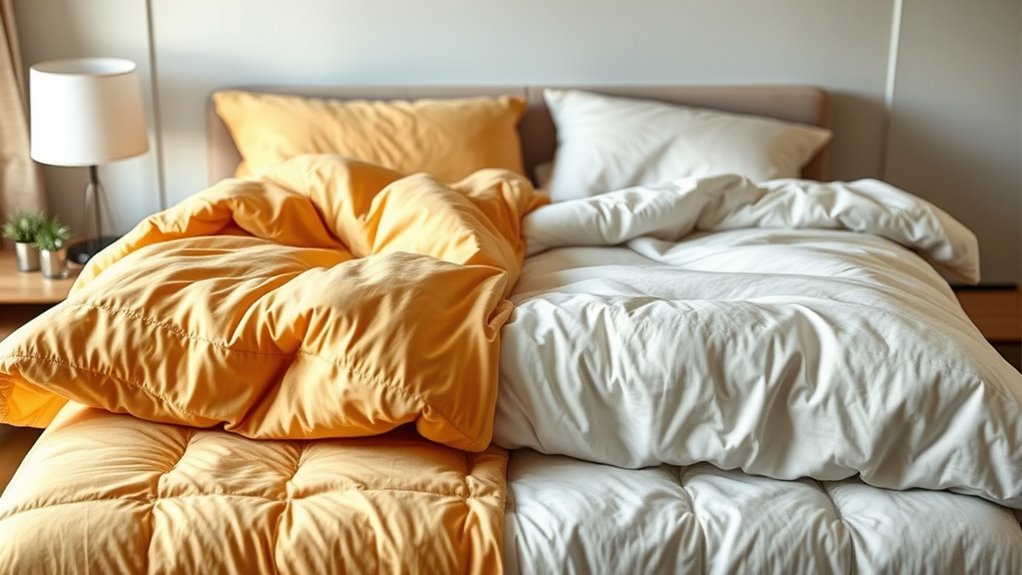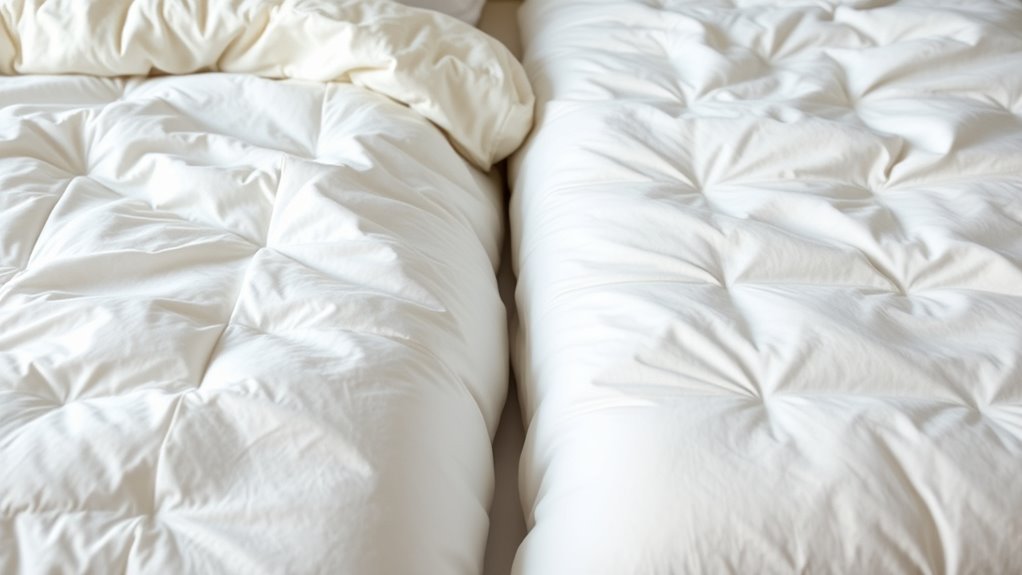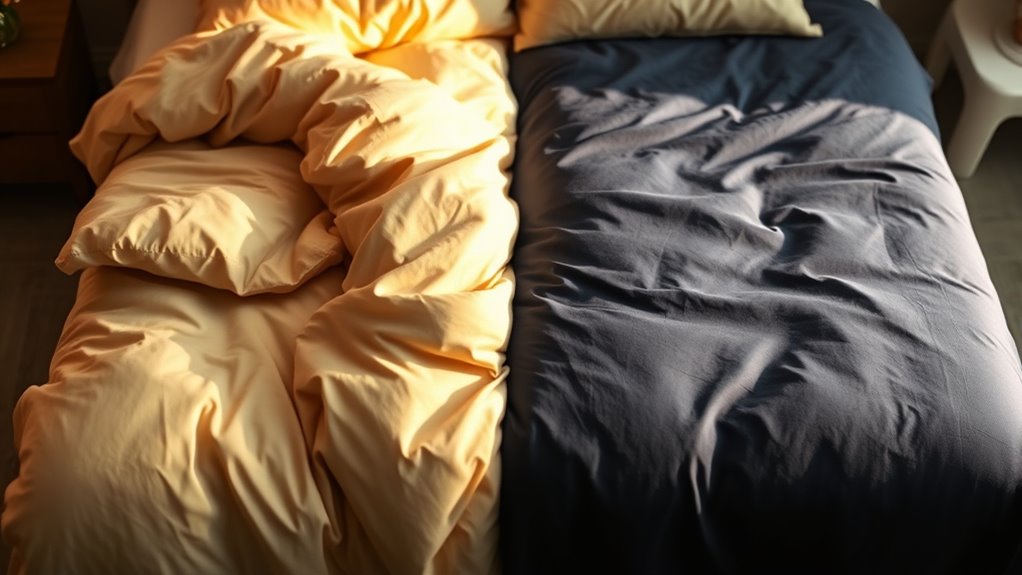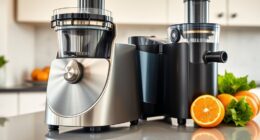Choosing between down and synthetic comforters depends on what matters most to you. Down offers superior insulation and a luxurious, airy feel that adapts to your movement, though it’s more expensive and requires special care. Synthetic options are budget-friendly, durable, and resistant to allergies, but tend to feel denser and need replacement sooner. To discover which comforter suits your sleep style and eco values best, keep exploring the differences.
Key Takeaways
- Down comforters provide superior loft, softness, and natural responsiveness, creating a luxurious and airy sleep experience.
- Synthetic comforters offer consistent warmth, are more affordable initially, and resist clumping and allergens better.
- Down lasts longer (15–20 years) with proper care, while synthetics typically need replacement every 3–5 years.
- Down is biodegradable and ethically sourced options support sustainability; synthetics are less eco-friendly and often non-biodegradable.
- Both insulate effectively, but down’s natural loft and airflow often deliver better temperature regulation during sleep.
The Insulation Power of Natural Down and Synthetic Fibers

Natural down and synthetic fibers both provide effective insulation, but they do so through different mechanisms. Natural down’s fill power, which ranges from 500 to 700, directly affects its loft and insulation capabilities. The loft creates air pockets that trap heat, making natural down highly efficient at heat retention and thermal regulation. Its complex cluster structure allows it to insulate without adding bulk, keeping you warm yet lightweight. Synthetic fibers, like polyester or microfiber, mimic this by trapping air in tiny pockets, offering comparable insulation. While natural down naturally regulates temperature to prevent overheating, synthetic fibers also trap heat effectively. Both materials create insulating layers that keep you warm, but natural down’s superior loft and fill power often mean better thermal performance in colder environments. Additionally, natural down’s ability to regulate temperature helps prevent overheating during sleep or cold weather activities. Advances in AI-driven textile manufacturing are also improving the performance and sustainability of synthetic insulations, making them more competitive with natural down. Furthermore, innovations in synthetic fiber technology are enhancing durability and moisture resistance, broadening their application in various climates.
How Each Comforter Type Feels During Sleep

During sleep, the feel of your comforter can substantially influence your overall comfort and rest quality. Down comforters provide a softness and plushness that mold gently around your body, creating a luxurious, airy, and cozy sensation. They respond to your movements, offering responsiveness and a natural feel. The natural materials in down also allow for better air circulation, which can help regulate temperature throughout the night. Synthetic comforters, on the other hand, tend to be more consistent in their plushness and warmth, often feeling denser and less airy. While they may lack the softness of down, they still provide a plush, cozy experience. Their insulation remains steady, making them ideal for those who prefer uniform warmth. Both types offer comfort, but down’s natural softness and responsiveness create a distinctly luxurious sleep feel, whereas synthetics deliver a more consistent, plush experience. The choice between them often depends on individual preferences for comfort and warmth.
Maintenance, Durability, and Long-Term Use Factors

When considering the long-term use of your comforter, maintenance and durability play key roles in guaranteeing it remains cozy and supportive over the years. Down comforters can last 15-20 years with proper care, thanks to their durable feather clusters that retain loft through repeated washing. Regular maintenance, including professional cleaning every 2-3 years, helps prevent allergen buildup and maintains loft. Down alternatives, on the other hand, typically last 3-5 years but are more resistant to damage from frequent laundering, making them practical for daily use. Proper washing and storage are essential for both types to extend their lifespan and prevent damage. Additionally, understanding the importance of sustainable materials can guide you in choosing a comforter that is both durable and environmentally friendly. Incorporating innovative fabric technology can also enhance longevity and comfort. Moreover, selecting high-quality filling ensures your comforter maintains its warmth and support over many years. Using proper storage techniques when not in use can significantly prolong the lifespan of your comforter by preventing damage from moisture and pests. Implementing appropriate cleaning methods further contributes to maintaining its integrity and longevity. Overall, consistent care boosts durability and ensures your comforter remains supportive and warm for the long term.
Cost Differences and Value Over Time

While down comforters tend to have a higher upfront cost, they often deliver better long-term value due to their durability and enduring comfort. Investing more initially can save you money over time since a quality down comforter lasts 15-20 years with proper care, providing greater longevity and consistent warmth. Synthetic options are more budget-friendly upfront, with prices typically between $50 and $300, but they usually need replacing every 3–5 years, reducing overall value. Consider this comparison:
| Comforter Type | Initial Price | Longevity |
|---|---|---|
| Down | $200–$1,000 | 15–20 years |
| Synthetic | $50–$300 | 3–5 years |
| Cost-Effectiveness | Longer-term savings | Less frequent replacements |
Your choice depends on whether you prioritize short-term savings or long-term investment. Additionally, understanding the longevity of each material can help inform a more strategic purchase decision. Choosing a sustainable comforter made from eco-friendly materials can also contribute to reducing environmental impacts associated with wood-burning practices and other unsustainable resource uses.
Environmental and Health Considerations

Choosing between down and synthetic comforters also involves considering their environmental and health impacts. Eco-friendly down options are biodegradable and renewable when ethically sourced, supporting sustainability and humane treatment. In contrast, synthetic comforters are made from non-biodegradable materials like polyester, which can contribute to plastic pollution unless recycled. Down can be naturally hypoallergenic if properly cleaned, making it suitable for sensitive skin, while synthetic materials resist dust mites and mold, benefiting allergy sufferers. Manufacturing synthetic comforters generally uses less water and energy compared to ethically sourcing down feathers. Both options have environmental impacts: down’s footprint depends on ethical sourcing, while synthetics may harm the environment unless recycled content is utilized. Your choice can reflect your values regarding sustainability, animal welfare, and health. Additionally, sourcing methods for down influence its overall environmental footprint and ethical considerations. Sustainable down sourcing practices ensure that the environmental and animal welfare impacts are minimized, making it a more responsible choice.
Frequently Asked Questions
Should I Get a Down or Synthetic Duvet?
You’re wondering whether to choose a down or synthetic duvet. If you want long-lasting, plush warmth and don’t mind a higher price, a down comforter is ideal. It’s breathable and lightweight, perfect for winter nights. On the other hand, if you’re budget-conscious, prone to allergies, or prefer low maintenance, a synthetic duvet offers better airflow, is hypoallergenic, and easier to care for. Consider your warmth needs and lifestyle when deciding.
What Comforter Material Is Best for Warmth?
You might think choosing the warmest comforter is as simple as picking the thickest one, but don’t be fooled. Natural down, especially with high fill power, creates tiny air pockets that trap heat perfectly, making you feel like you’re wrapped in a cloud. Synthetic options also trap heat well, but natural down wins for that lightweight, cozy warmth. So, if warmth’s your goal, go natural—your sleep will thank you.
Do Hotels Use Down or Down Alternative Comforters?
Hotels typically choose between down and down alternative comforters based on their priorities. If you stay at a luxury hotel, chances are they use down comforters for their plush feel and superior insulation. Budget hotels often opt for down alternatives because they’re more affordable, easier to clean, and hypoallergenic. Your comfort and the hotel’s standards guide their choice, balancing luxury, cost, sustainability, and guest allergies.
What Is the Downside to Down Comforters?
Imagine cozy warmth hiding some hidden pitfalls—that’s what a down comforter can be. You might find it traps dust mites and mold if not cleaned properly, risking allergies. It often needs professional cleaning, which costs time and money. Over time, it may lose its fluff, and feathers can shed, causing discomfort. Plus, ethical concerns about sourcing add to the downsides, making you think twice before cuddling up.
Conclusion
As you weigh your options, remember that both down and synthetic comforters offer unique benefits—yet the choice isn’t just about warmth. It’s about what truly aligns with your values, lifestyle, and future needs. Will you prioritize eco-friendliness, longevity, or cost? The decision isn’t simple, and the final verdict might surprise you. Whichever you choose, your perfect night’s sleep awaits—just a decision away. Are you ready to uncover the comfort that’s right for you?









